How Does Costmetic Makeup Inpact Our Everyday Lives
Cosmetics are non a modern invention. Humans have used various substances to modify their appearance or accentuate their features for at least 10,000 years, and perhaps a lot longer.
Women in Ancient Egypt used kohl, a substance containing powdered galena (lead sulphide—PbS) to darken their eyelids, and Cleopatra is said to have bathed in milk to whiten and soften her skin. By 3000 B.C men and women in China had begun to stain their fingernails with colours according to their social class, while Greek women used poisonous atomic number 82 carbonate (PbCO3) to achieve a pale complexion. Clays were ground into pastes for cosmetic use in traditional African societies and indigenous Australians nonetheless use a wide range of crushed rocks and minerals to create trunk paint for ceremonies and initiations.
Today, cosmetics are large business organisation. According to the 2011 Household Expenditure Survey, conducted every five years by the Australian Bureau of Statistics, Australians spend effectually $iv.five billion on toiletries and cosmetic products every twelvemonth. Cosmetic ad, previously directed mainly at women, is now targeting a wider audience than ever.
Cosmetic chemicals interactive
Select the dazzler products you apply below and find out how many chemicals they contain!
Total products: 0
Total chemicals: 0
What is a cosmetic?
In Australia, a cosmetic is divers under the Industrial Chemical (Notification and Cess) Act 1989 as 'a substance or preparation intended for placement in contact with any external role of the homo body' (this includes the mouth and teeth). We use cosmetics to cleanse, perfume, protect and change the appearance of our bodies or to modify its odours. In contrast, products that claim to 'alter a bodily procedure or forestall, diagnose, cure or alleviate any affliction, ailment or defect' are called therapeutics. This distinction means that shampoos and deodorants are placed in the cosmetics category, whilst anti-dandruff shampoos and antiperspirants are considered to be therapeutics.
Regulation and safety
In Australia, the importation, manufacture and utilize of chemicals—including those used in cosmetics—are regulated by the Australian Authorities'southward National Industrial Chemicals Notification and Assessment Scheme (NICNAS). NICNAS works to ensure that chemicals used in consumer products practise not cause significant damage to users or to the environment.
In the example of cosmetics, every ingredient contained within the product must be scientifically assessed and canonical past NICNAS before being manufactured or imported into Australia and earlier they tin can be used in consumer products. Where advisable, NICNAS sets limits on the level at which a chemical can be used in a product and likewise conducts reviews on chemicals when new testify arises.
Cosmetic products that make an boosted therapeutic claim (such as moisturisers that also lighten the skin) are regulated by a different organisation—the Therapeutic Appurtenances Administration (TGA).
Cosmetics and other personal care items must too exist labelled in accordance with the Merchandise Practices (Consumer Product Information Standards, Cosmetics) Regulations 1991. This regulation requires that all intentionally added ingredients are listed on the product characterization, and is enforced by the Australian Competition and Consumer Commission (ACCC).
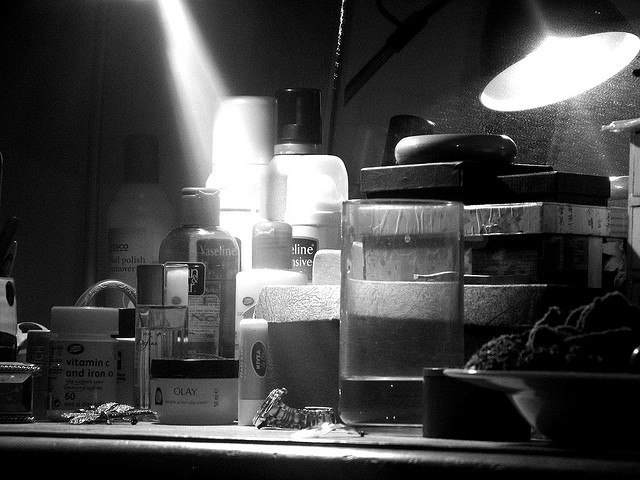
What practice cosmetics comprise?
There are thousands of different cosmetic products on the market place, all with differing combinations of ingredients. In the Us alone there are approximately 12,500 unique chemical ingredients approved for utilise in the manufacture of personal intendance products.
A typical product will contain anything from 15–l ingredients. Considering the boilerplate woman uses betwixt 9 and 15 personal care products per day, researchers accept estimated that, when combined with the addition of perfumes, women place around 515 individual chemicals on their skin each mean solar day through cosmetic employ.
But what exactly are nosotros putting on our skin? What practise those long names on the ingredient list mean and what do they practise? While the formula of each product differs slightly, most cosmetics comprise a combination of at least some of the following core ingredients: water, emulsifier, preservative, thickener, emollient, colour, fragrance and pH stabilisers.
Water
If your product comes in a bottle, chances are the beginning ingredient on the list is going to exist water. That'due south right, skilful old H2O. Water forms the basis of nearly every type of corrective product, including creams, lotions, makeup, deodorants, shampoos and conditioners. Water plays an important part in the procedure, often acting as a solvent to dissolve other ingredients and forming emulsions for consistency.
Water used in the formulation of cosmetics is not your everyday, regular tap water. It must be 'ultra-pure'—that is, free from microbes, toxins and other pollutants. For this reason your label may refer to information technology as distilled water, purified water or just aqua.
Emulsifiers
The term emulsifiers refers to any ingredient that helps to keep unlike substances (such as oil and water) from separating. Many cosmetic products are based on emulsions—small-scale droplets of oil dispersed in water or small aerosol of water dispersed in oil. Since oil and water don't mix no matter how much you milk shake, blend or stir, emulsifiers are added to change the surface tension between the water and the oil, producing a homogeneous and well-mixed product with an even texture. Examples of emulsifiers used in cosmetics include polysorbates, laureth-iv, and potassium cetyl sulfate.
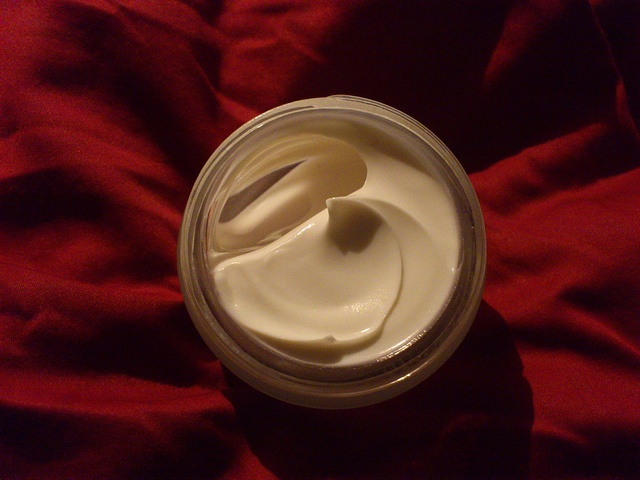
Preservatives
Preservatives are important ingredients. They are added to cosmetics to extend their shelf life and foreclose the growth of microorganisms such as bacteria and fungi, which tin can spoil the product and perchance damage the user. Since near microbes live in water, the preservatives used need to be water-soluble, and this helps to determine which ones are used. Preservatives used in cosmetics can be natural or synthetic (homo-made), and perform differently depending on the conception of the production. Some volition require low levels of around 0.01%, while other will require levels as high as 5%.
Some of the more popular preservatives include parabens, benzyl booze, salicylic acrid, formaldehyde and tetrasodium EDTA (ethylenediaminetetra-acetic acid).
Consumers who purchase 'preservative-free' products should exist aware of their shorter shelf life and exist conscious of any changes to the await, experience or odour of the product that may indicate it has gone off.
Thickeners
Thickening agents work to give products an appealing consistency. They tin come from four dissimilar chemical families:
Lipid thickeners are ordinarily solid at room temperature but can be liquefied and added to corrective emulsions. They work past imparting their natural thickness to the formula. Examples include cetyl alcohol, stearic acid and carnauba wax.
Naturally derived thickeners come, equally the proper noun suggests, from nature. They are polymers that absorb water, causing them to groovy upward and increment the viscosity of a product. Examples include hydroxyethyl cellulose, guar gum, xanthan gum and gelatin. Cosmetics with a consistency that is also thick tin be diluted with solvents such as water or alcohol.
Mineral thickeners are likewise natural, and as with the naturally derived thickeners mentioned above, they absorb h2o and oils to increment viscosity, but give a dissimilar effect to the final emulsion than the gums. Popular mineral thickeners include magnesium aluminium silicate, silica and bentonite.
The last group are the synthetic thickeners. They are often used in lotion and cream products. The nearly mutual constructed thickener is carbomer, an acrylic acid polymer that is water-swellable and tin be used to form clear gels. Other examples include cetyl palmitate, and ammonium acryloyldimethyltaurate.
Emollient
Emollients soften the skin by preventing water loss. They are used in a broad range of lipsticks, lotions and cosmetics. A number of different natural and synthetic chemicals work as emollients, including beeswax, olive oil, coconut oil and lanolin, also as petrolatum (petroleum jelly), mineral oil, glycerine, zinc oxide, butyl stearate and diglycol laurate.
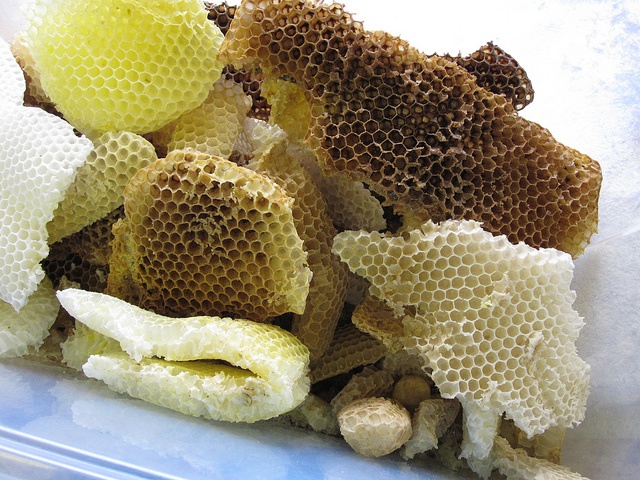
Colouring agents/pigments
Carmine lips, smoky optics and rosy cheeks; it is the purpose of many cosmetics to accentuate or change a person's natural colouring. A huge range of substances are used to provide the rainbow of appealing colours you discover in the makeup stand. Mineral ingredients can include iron oxide, mica flakes, manganese, chromium oxide and coal tar. Natural colours tin can come from plants, such as beet powder, or from animals, like the cochineal insect. The latter is often used in red lipsticks and referred to on your ingredient list as carmine, cochineal extract or natural crimson 4.
Pigments tin can be split into two main categories: organic, which are carbon-based molecules (i.e. organic in the chemistry context, non to be confused with the use of the give-and-take to promote 'natural' or 'non-constructed' or 'chemic-free' products) and inorganic which are more often than not metal oxides (metal + oxygen and ofttimes some other elements also). Inorganic should not be confused with 'constructed' or 'unnatural' as nigh of the inorganic metal oxide pigments practise occur naturally equally mineral compounds.
The ii most mutual organic pigments are lakes and toners. The lake pigments are made by combining a dye colour with an insoluble substance like alumina hydrate. This causes the dye to get insoluble in water, making it suitable for cosmetics where water-resistant or waterproof backdrop are desired.
A toner pigment is an organic pigment that has not been combined with whatsoever other substance.
The inorganic metal oxide pigments are normally duller than the organic pigments, but are more than resistant to estrus and light, providing a longer-lasting colour.
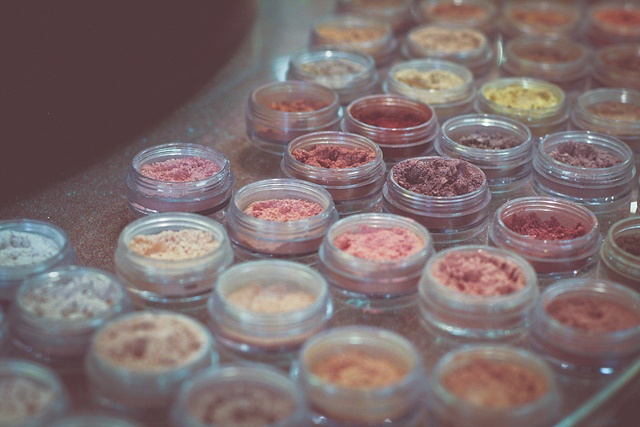
Blink and shine
Shimmering effects can be created via a range of materials. Some of the most common ones are mica and bismuth oxychloride.
Cosmetic mica typically comes from muscovite (KAl2(AlSi3O10)(F,OH)two) too known as white mica. Information technology naturally forms in flaky sheets and these are crushed up into fine powders. The tiny particles in the powders refract (curve) calorie-free, which creates the shimmering upshot common in many cosmetics. Mica coated with titanium dioxide gives a whitish appearance when looked at directly on, merely then produces a range of iridescent colours when viewed from an angle.
Bismuth oxychloride (BiClO) is used to create a argent grey pearly consequence. This compound occurs naturally in the rare mineral bismoclite, but is ordinarily produced synthetically and so is also known as constructed pearl.
The size of the particles used to create pearly and shimmering looks bear on the degree of blink the production has. The smaller the particle size (15–sixty microns, where one micron is one millionth of a meter), the less lustrous the powder will be, and more coverage it gives. Larger particle sizes, up to 500 microns, give a more than glittery lustre and are more than transparent.
Fragrances
No matter how constructive a cosmetic may be, no one volition want to utilise it if it smells unpleasant. Consumer research indicates that smell is i of the key factors in a consumer's decision to purchase and/or employ a product.
Chemicals, both natural and synthetic, are added to cosmetics to provide an appealing fragrance. Fifty-fifty 'unscented' products may contain masking fragrances to mask the olfactory property of other chemicals.
The term 'fragrance' is oft a generic term used by manufacturers. A single list of fragrance on your product'southward ingredient listing could represent dozens or fifty-fifty hundreds of unlisted chemical compounds which were used to create the final private fragrance.
Manufacturers practice not accept to list these private ingredients as fragrance is considered to be a trade secret .
There are over 3,000 chemicals used to formulate the huge range of fragrances used in consumer products worldwide. A comprehensive listing has been published by the fragrance industry. All the ingredients on this list have passed the International Fragrance Association (IFRA) safe standards for utilise in commercial products. Nonetheless, without knowing which private ingredients went in to making upwards the fragrance of a product, consumers tin observe it difficult to make informed choices. If consumers are concerned they should look for fragrance gratis products and buy from companies that label their products more comprehensively.
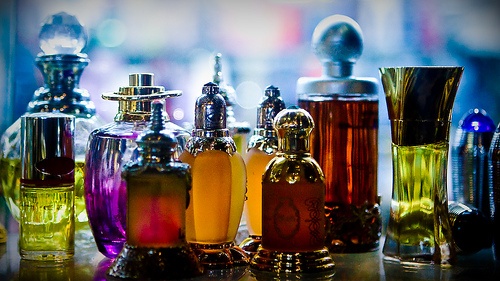
Are cosmetics unsafe?
There's cipher like a scrap of controversy to generate some media buzz. For over a decade there have been recurring reports in both the media and on hundreds of internet sites relating to potentially toxic substances nowadays in cosmetics (pb, mercury, parabens) and the dangers they pose to the public. Should consumers exist worried? Are these claims backed upwards by reputable, published scientific research or have the findings been misinterpreted and exaggerated? Let'southward accept a await …
Parabens
Parabens are a class of chemicals commonly used equally preservatives in food, therapeutic and corrective products. They are derived from para-hydroxybenzoic acrid (PHBA), which occurs naturally in many fruits and vegetables. Parabens come in several forms: methylparaben, ethylparaben, propylparaben, butylparaben and isobutylparaben. They are the almost widely used preservative in personal intendance products. This is because they are incredibly good at doing their job—keeping your products mould and bacteria free—and are also toll constructive.
The utilise of parabens in cosmetics hit the media in 2004 after a research study conducted by Dr. Philippa Darbre of the University of Reading in England reported findings that 18 out of 20 chest cancer tissue samples contained parabens. As parabens tin can weakly mimic the actions of oestrogen, and equally oestrogen can raise tumour growth, this was thought to be a problem. The presence of parabens in chest tumours was picked up past the media and presented as testify that parabens contribute to breast cancer. This was incorrect.
While the presence of parabens is notable, the study plant no direct evidence that they had caused the cancer or contributed to its growth. Breast tumours have a large claret supply, then it is probable that whatever chemical constitute in the claret stream will be nowadays in the tumour.
In a later argument to the media, Dr. Darbre, referring to her 2004 study, said 'No claim was made that the presence of parabens has acquired the breast cancers.'
There take since been dozens of studies undertaken around the globe on the safety of parabens, which time and once again have exhaustively demonstrated that parabens are broken down, metabolised and excreted harmlessly from the body.
Currently, both in Australia and internationally, the scientific discipline community consider the apply of parabens in cosmetics to exist condom.
In response to consumer demand, some companies accept begun to manufacture paraben free products, which consumers can purchase if they are concerned.
Aluminium
Concerns regarding cancer are also linked to the use of aluminium in deodorants and anti-perspirants. In the early on 2000s diverse news outlets reported credible links between the use of antiperspirants containing aluminium and breast cancer. Similar reports connected the use of such products to the onset of Alzheimer's disease. These supposed links accept never been scientifically proven despite multiple studies.
Aluminium works to cake the sweat ducts to reduce sweating. Some fence that this process prevents united states from releasing toxins, causing them to build upwardly within our lymph glands. Yet, breast cancer tumours do not originate in the lymph nodes, they start in the breast, and travel to the lymph nodes later. Another report found no deviation in the concentration of aluminium between the cancer and the surrounding tissue.
Currently at that place is no articulate link between the utilise of under-arm products containing aluminium and breast cancer.
Also, studies have shown no relationship between Alzheimer's disease and deodorant/antiperspirant use. Every day, humans are exposed to aluminium through food, packaging, pots and pans, medicine and even air and water. The official position of both the Alzheimer'south Society (U.s.a.) and Alzheimer'due south Australia is that a link betwixt environmental aluminium assimilation and Alzheimer's disease seems 'increasingly unlikely'.
Despite these findings, some manufacturers have begun producing aluminium-free products for consumers who nonetheless concord concerns.
Triclosan
Triclosan was originally adult as an anti-bacterial agent for use in hospitals, primarily equally a surgical scrub. However its usefulness has seen it increasingly added to a wide range of consumer products including deodorant, soap, toothpaste, cosmetics and general house-concur cleaning products. Triclosan is also used as a pesticide and can, under certain circumstances, break down into potentially toxic chemicals such as dioxins.
Triclosan hit the news in 2000 afterward findings published by the National University of Sciences (US) noted rising levels of the chemical being detected in the surround and its increasingly wide use in everyday products as concerns.
Studies conducted past scientists at the University of California found that prolonged exposure to triclosan causes liver fibrosis and cancer in laboratory mice. Other studies have suggested triclosan can disrupt hormones, impair muscle wrinkle and reduce bacterial resistance.
Whilst the over-use of triclosan in products warrants further study, Australian experts have highlighted its value and importance when used correctly and in moderation. Professor of Dental Scientific discipline at the University of Queensland, Dr. Laurie Walsh, noted that the chemical has been proven to fight various conditions such every bit gingivitis, inflammation and bleeding gums.
In Australia, a full gamble assessment conducted by NICNAS found no cause for public concern in general, though did recommend controls for maximum concentrations of triclosan (0.3%) in personal intendance and corrective products. At present, corrective products containing more than 0.3% triclosan must clearly carry the discussion 'toxicant' on the label—not the best marketing strategy for producers.
The American Food and Drug Administration (FDA) is planning to release an updated report on Triclosan in 2016, though in the interim consumers may look for triclosan-gratis products if they wish.
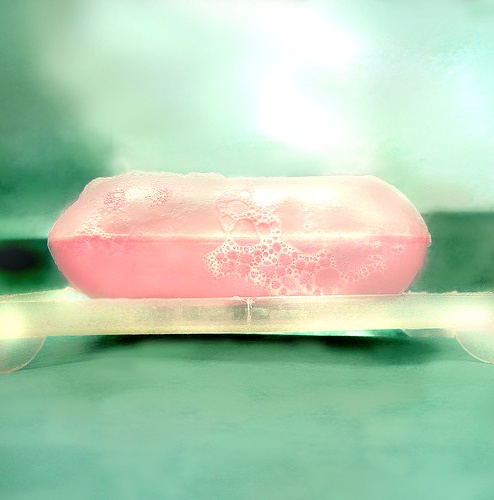
Formaldehyde
Formaldehyde is an organic compound with a wide variety of uses. Although unremarkably associated with embalming, it is too used in the manufacture of building materials, textiles, household cleaning products, plastics, cosmetics and personal care products. It also occurs naturally in a wide range of foods, for example the humble egg.
Formaldehyde is non typically used in its pure class, just altered slightly and listed under the name formalin. Information technology works equally a preservative to protect products from contamination.
Formaldehyde is classified as a Group i carcinogen (known to cause cancer in humans) by the Earth Wellness Organization International Bureau for Research on Cancer. It can besides cause peel and sensory irritation and animate difficulties in people when inhaled, ingested or if information technology comes into contact with skin. Then why is information technology still used in everyday products?
As with other chemicals, it is the concentration present in a production that is important. NICNAS has assessed formaldehyde and gear up maximum safe limits for its use in cosmetics. Oral products such equally toothpastes may only incorporate up to 0.1 percent formaldehyde, while smash hardeners tin can have up to 5 per centum. All other cosmetic products (such equally shampoos and straightening solutions) can have up to 0.2 percentage. At these low levels, the utilize of formaldehyde is deemed to be safe.
NICNAS has noted that people with specially sensitive skin may still experience irritation fifty-fifty at these low concentrations.
In 2010, the Australian Competition and Consumer Commission (ACCC) conducted a survey of the formaldehyde concentrations of several cosmetic products that resulted in the voluntary recall of 2 products that contained unacceptably loftier concentrations of the chemic.
Phthalates
Phthalates (pronounced THAL-ates) are some other group of chemicals constitute in some cosmetics that have been red-flagged by environmental groups. They are generally used to make plastic products soft and flexible but tin also be constitute in cosmetics similar nail shine, hair spray (to brand the products less brittle or stiff) and perfumes.
Phthalates are produced from oil and at that place are more than 20 types in common employ. As the various phthalates have different chemical structures, toxicity profiles and uses, their rubber should not be generalised every bit a grouping, just looked at on an individual basis. Some studies have indicated that at high, recurring concentrations dissimilar phthalates can act as endocrine disruptors—this ways they upset the hormonal balance in the body and can atomic number 82 to developmental problems, peculiarly in males. Other studies have indicated there may be a link between phthalates and blazon 2 diabetes.
In response, the European Spousal relationship and the United States have imposed bans on some types of phthalates for use in cosmetics. Research conducted in Australia has identified a small level of risk in relation to one phthalate, bis(2-ethylhexyl) phthalate or DEHP, and every bit a issue NICNAS has prohibited products that contain DEHP above the prescribed level—this generally relates to children'due south toys.
Pb in your lipstick?
News reports detailing levels of lead and other metals in lipsticks are persistent and recurring, only should consumers exist worried? A 2013 written report by the University of California Berkley examined the metal content of 32 different lipsticks. Researchers found traces of aluminium, manganese (which can cause neurological bug) and titanium in all the products they tested, while three-quarters of the products independent lead (which affects the nervous system, and can crusade learning disabilities in children). Many of the lipsticks and lip glosses as well contained nickel and cobalt, besides as cadmium and chromium—both known carcinogens.
Why would manufacturers add these ingredients to their products? The answer is—they don't. They exist in the products as 'impurities', that is, they are present in other ingredients such every bit the wax, oils or the mineral pigments used in the formula. Because of the persistent nature of these substances and the fact they occur in the natural environment, including in h2o, it is almost impossible to remove all traces of them.
However don't throw your lippy abroad just yet. The presence of these naturally-occurring elements in lipsticks is non necessarily a problem—the important event is the level or concentration. Are the the levels high enough to be considered toxic, or are they depression enough to be accounted safety? Remember, sunlight is also a proven carcinogen (skin cancer)—just yous still get outside and y'all might even sunbathe. Information technology all comes down to dose.
With the exception of chromium, the study concluded that the metal concentrations were comfortably within the 'adequate daily allowances' as adamant by the researchers via a comparison with accepted water and air contamination levels. Basically, you will eat more than pb from drinking water than you volition from applying lipstick. However, the study did conclude that farther research into the metal content of cosmetic products is necessary, specially with respect to chromium.
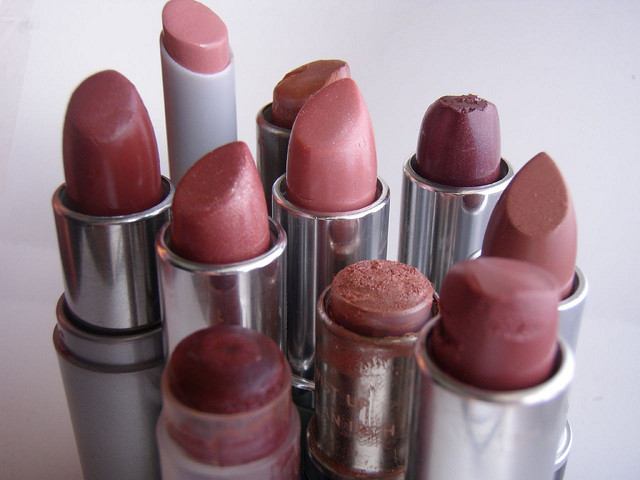
Sun creams
While sun creams are non officially cosmetics (they are considered to exist therapeutics), nosotros volition include them here as their employ is so common, specially in Australia.
Sunscreens play an important role in protecting our skin from the harmful UVA and UVB rays emitted by the lord's day. Their employ has been proven to aid prevent certain skin cancers including melanomas and basal prison cell carcinomas.
In recent years there has been some business concern well-nigh nanoparticles (NP) in sunscreens. This relates especially to zinc oxide (ZnO) and titanium dioxide (TiO₂) nanoparticles and their ability to penetrate the skin to reach cells and the potential toxicity exerted by these chemicals.
The position of the Therapeutic Goods Administration (TGA), based on several published papers (up to May 2013) as well as reviews of international authorities, is that nano-particles are rubber. 'Several in vitro and in vivo studies using both brute and human skin take shown that these NPs do non penetrate the underlying layers of pare, with penetration limited to the stratum corneum. This suggests that systemic absorption is unlikely.'
A further study published in 2014 constitute that when exposed to zinc oxide nanoparticles, human immune cells (called macrophages) effectively captivated the nanoparticles and broke them downwards.
Based on current evidence, neither TiO2 nor ZnO nanoparticles are probable to cause harm when used every bit ingredients in sunscreens. At that place are more risks associated with avoiding suncreams (sunburn, skin cancers) than in that location are posed by nanoparticles.
Conclusion
While the current scientific thinking on many of these chemicals is that they are safe to use, it is up to each consumer to make their own decision as to whether they buy and utilise a production containing certain ingredients or non. Consumers should also effort to purchase reputable brands from established sellers—inexpensive imports or copies bought online may non have been through the proper testing and cess process and may not incorporate what they claim to.
In our pursuit of beauty, information technology is wise to remember that cosmetics can be complex combinations of chemicals. Achieving fifty-fifty a basic understanding of the long chemical names on a product ingredient listing—what they are and what they do—tin can get a long way to helping consumers make informed decisions about the products they choose to use—certainly helpful when putting on your best face up.
How Does Costmetic Makeup Inpact Our Everyday Lives,
Source: https://www.science.org.au/curious/people-medicine/chemistry-cosmetics
Posted by: greenlyharsecy.blogspot.com


0 Response to "How Does Costmetic Makeup Inpact Our Everyday Lives"
Post a Comment